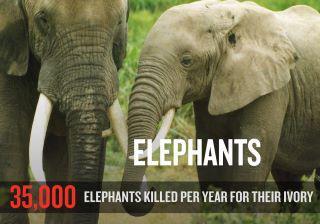Introduction
The ivory trade is the primary reason that the endangered elephant population world wide is diminishing at an alarming rate.
Other species killed for their ivory tusks are the hippopotamus, walrus, narwhal and mammoth.
Poachers move from place to place where the elephant population has not yet been obliterated, wiping it out wherever they go. Despite an international ivory trade ban being in place, there has recently been a surge in this illegal and brutal practice.
Image: Poachers kill elephants using methods such as using a poisoned dart – which results in a slow and excruciatingly painful death for the animal, by shooting them with machine guns, or even stoning them to death. Poachers slaughter entire herds of elephants when they gather to drink at waterholes.

Ad:







